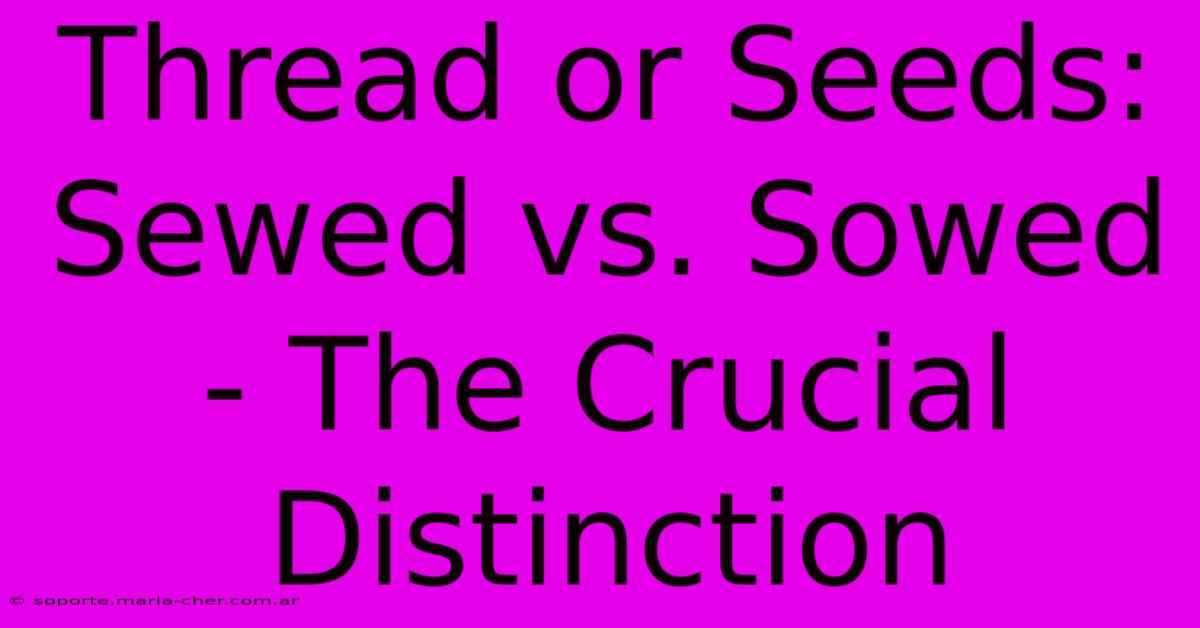Thread Or Seeds: Sewed Vs. Sowed - The Crucial Distinction

Table of Contents
Thread or Seeds: Sewed vs. Sowed - The Crucial Distinction
Many people confuse the words "sewed" and "sowed," often using them interchangeably. However, these words, while similar in sound, have vastly different meanings and should never be used in place of one another. Understanding the distinction is crucial for clear and accurate writing. This article will illuminate the difference between "sewed" and "sowed," helping you avoid common grammatical errors and enhance your writing precision.
Understanding "Sewed"
Sewed is the past tense of the verb "to sew." Sewing involves using a needle and thread to join pieces of fabric together. Think of creating garments, mending clothes, or stitching quilts. The action involves needlework and textile craft.
Here are some examples of "sewed" in a sentence:
- "Grandma sewed me a beautiful patchwork quilt."
- "I carefully sewed the button back onto my shirt."
- "The tailor expertly sewed the tear in my pants."
Synonyms for Sewed:
- Stitched
- Darned
- Repaired (in the context of fabric)
Understanding "Sowed"
Sowed is the past tense of the verb "to sow," which primarily relates to planting seeds. It's an agricultural term, referring to the scattering or planting of seeds in the ground to cultivate crops. Think of farmers working the land, gardeners tending their plots, or even the natural dispersal of seeds by wind or animals.
Here are some examples of "sowed" in a sentence:
- "The farmer sowed his fields with wheat in the spring."
- "She sowed sunflower seeds in her garden."
- "The wind sowed the dandelion seeds across the meadow."
Synonyms for Sowed:
- Planted
- Scattered (in the context of seeds)
- Disseminated (in a more formal context)
The Key Difference: Fabric vs. Fields
The simplest way to remember the difference is to associate sewed with sewing (fabric) and sowed with sowing (seeds). One involves needle and thread; the other involves planting seeds in the earth. Keeping this visual distinction in mind will help avoid confusion.
Common Mistakes and How to Avoid Them
A common error is using "sowed" when "sewed" is correct, or vice versa. This can significantly impact the clarity and accuracy of your writing. Always double-check the context to ensure you're using the appropriate past tense verb.
Example of Incorrect Usage: "She sowed a button onto her coat." (Incorrect – should be "sewed")
Example of Incorrect Usage: "The farmer sewed his field with corn." (Incorrect – should be "sowed")
By carefully considering the context and the action being described, you can easily avoid making this mistake.
Conclusion: Precision in Language Matters
Mastering the difference between "sewed" and "sowed" demonstrates a strong command of the English language. While seemingly minor, this distinction showcases attention to detail and enhances the overall quality of your writing. Remember the association: sewed for fabric, sowed for seeds, and you’ll be well on your way to avoiding this common grammatical pitfall. Clear communication hinges on precise word choice, and understanding this subtle difference is a valuable step towards achieving that clarity.

Thank you for visiting our website wich cover about Thread Or Seeds: Sewed Vs. Sowed - The Crucial Distinction. We hope the information provided has been useful to you. Feel free to contact us if you have any questions or need further assistance. See you next time and dont miss to bookmark.
Featured Posts
-
Capture Lifes Moments In Cinematic Glory With The Sony Alpha 300 Dslr
Feb 07, 2025
-
Peek Into The Past With Visconti Sforza A Historical Journey Through Tarot
Feb 07, 2025
-
Clickbait Alert These Fake Ads Are Too Good To Ignore
Feb 07, 2025
-
Accessorize Like A Pro The Art Of Styling Gold Vermeil Bracelets
Feb 07, 2025
-
Unveiling The Invisible The Baseline Mystery Revealed
Feb 07, 2025
